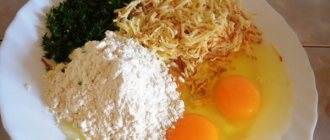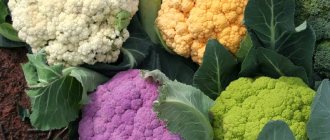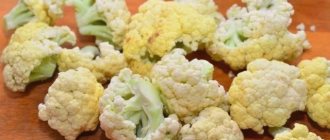Tips and secrets from experienced chefs
- Choose young cauliflower, without damage or spots on the surface. You can determine the freshness of the fruit by its soft green leaves and creamy surface of the inflorescences.
- Darkened and wilted cabbage means that the vegetable has become stale and has lost its juiciness.
- It is consumed raw, for example, in salads. But this cauliflower is not suitable for every stomach. Therefore, it is safer to subject it to heat treatment: bake, fry alone or in batter, marinate, steam.
- Before cooking, the cabbage must be washed, disassembled into inflorescences and filled with salted water for 12-15 minutes so that the remaining insects float to the surface. For 1 liter of liquid take 1 tbsp. salt.
- After soaking in salted water, the inflorescences should be washed, placed on a sieve and dried.
- It is better to cook the inflorescences in a stainless steel pan over low heat.
- All trace elements in cauliflower are better preserved if you cook it in a pressure cooker. For the same purpose, cauliflower is prepared in a double boiler and cauliflower in a slow cooker.
- You can fry and stew both fresh and frozen cabbage. To do this, it is better to pre-boil it for 5 minutes, dry it and drain it in a colander.
- Regardless of the method of preparing cauliflower, it should not be overcooked, otherwise it will not be tasty or healthy.
- For spice, various spices and herbs are added to the dish, which will saturate the neutral taste of cauliflower.
- You can remove the cabbage smell, which many people don’t like, by boiling the inflorescences for 4 minutes with a sprig of rosemary and lemon zest. You can also get rid of the unpleasant taste and smell by draining the first water (it will be yellow-green), which will remove the unpleasant aroma.
- Cauliflower can be served as a side dish, made into a salad, made into soup, etc.
- The closest relative of cauliflower is broccoli, which is distinguished by its bright green color and richer vitamin composition. Therefore, these cabbage varieties are interchangeable.
- To blanch, soak the cabbage in boiling water for 5-7 minutes. After this, it can be cooked further (baked, fried) or added to salads.
- Boil cabbage for 10-13 minutes. After cooking, place it in cold water with ice and soak for 2-3 minutes to stop the cooking process. Otherwise it will be overcooked.
Useful properties of cauliflower
Thanks to such a complex and rich composition, cauliflower can be considered a valuable food product, as well as an effective remedy for many diseases.
Cauliflower enzymes are complex organic substances, without which the millions of biochemical reactions constantly occurring in our body are impossible; they actively remove toxins from our body, and vitamins and minerals improve antioxidant protection.
The combined action of these substances helps prevent damage and deformation of cells, and therefore the appearance and development of tumors - therefore, cauliflower, like broccoli, can prevent and slow down the development of cancer - especially breast cancer in women and prostate cancer in men.
For diseases of the gastrointestinal tract, endocrine system, respiratory and urinary tract, cauliflower is a necessary element of therapeutic nutrition.
The cellular structure of cauliflower is thinner, it contains little coarse fiber, so it does not irritate the gastric mucosa and is easier to digest and absorb by the body.
Many doctors recommend cauliflower for patients with gastritis, stomach ulcers, and also for use in baby food. For example, if the secretion of gastric juice is weak, a diet of boiled cauliflower is recommended; It is also indicated for diseases of the liver and gall bladder, as it promotes bile secretion and intestinal function.
Cauliflower in batter
The most common way to prepare cauliflower is by roasting it. To reduce the roasting time, pre-boil the inflorescences for no longer than 5 minutes. Then the cabbage will be softer and juicier. But to get crispy pieces, the inflorescences are fried raw.
- Calorie content per 100 g - 89 kcal.
- Number of servings - 4-5
- Cooking time - 30 minutes
Ingredients:
- Cauliflower – 1 kg (frozen or fresh)
- Vegetable oil - how much you need for frying and 1 tbsp. for batter
- Flour - 1 tbsp.
- Water - 1 tbsp.
- Soda - 0.5 tsp.
- Curry - a pinch
- Vinegar 9% - 1 tbsp.
- Ground black pepper - to taste
- Garlic - 1 clove
- Salt - to taste
Cooking cauliflower in lean batter:
- For the batter, pour slightly warm water into a bowl, add sifted flour and stir with a fork until smooth.
- Add soda, slaked with vinegar, spices and herbs. Then pour in the oil, squeeze the garlic through a press and whisk. Leave the batter to sit for half an hour.
- Disassemble the head of cabbage into inflorescences, put them in boiling water, boil for 5 minutes in salted water, drain in a colander and cool.
- Pour vegetable oil into a frying pan and heat.
- Dip the cauliflower in the batter and set aside to fry. It is convenient to dip it using the stems of the inflorescences, so it is better not to cut them off. If the legs are cut off, use a fork or skewer to process.
- Cook the cabbage over medium heat for 1 minute on each side until it turns a nice golden color.
- Place the cabbage on a paper napkin to absorb excess oil and serve the vegetables.
How to cook cauliflower: 10 great recipes
dietdoctor.
com
- 1 head of cauliflower;
- 1 lemon;
- 2 cloves of garlic;
- 1 tablespoon chopped fresh ginger;
- 1 tablespoon chopped onion;
- 1 tablespoon turmeric;
- 1 teaspoon sea salt;
- 120 ml Greek yogurt or coconut milk;
- 120 ml olive or melted butter;
- a few sprigs of parsley.
Remove the leaves from the cauliflower and place it in a plastic bag. Mix lemon juice, minced garlic, ginger, onion, turmeric, salt and yogurt. Pour the marinade into the bag, close it and shake well. Place the bag in the refrigerator for at least an hour. To marinate the cabbage better, leave it in the refrigerator overnight.
Place the pickled cauliflower on a baking sheet and bake in an oven preheated to 180°C for 45–60 minutes. It should soften on the inside and brown on the outside.
Before serving, baste the cabbage with oil and sprinkle with chopped parsley leaves.
Ingredients
- 1 teaspoon cumin (cumin);
- 2 teaspoons mustard seeds;
- ½ teaspoon chili powder;
- 1 teaspoon black peppercorns;
- 200g self-raising flour (or 200g plain flour and 1¹⁄₂ teaspoon baking powder);
- ½ teaspoon turmeric;
- 350 ml cold beer;
- sea salt - to taste;
- 1 head of cauliflower;
- ½ cup olive oil;
- ½ bunch of parsley;
- 1 lemon.
Preparation
Grind the cumin, mustard seeds, chili and black pepper well in a mortar. Mix the resulting powder with flour and turmeric. Pour in almost all the beer and whisk thoroughly. The consistency of the batter should resemble thick cream. If it's too thick, add more beer. Then season the batter with sea salt.
Disassemble the cauliflower into small florets, and cut the stalk into pieces 2 cm thick. Rinse the cabbage and drain in a colander. All excess liquid should drain off. Remaining water can be blotted with a paper towel. Place the cabbage in a bowl and sprinkle with regular flour.
Heat the oil in a deep saucepan. Remove excess flour from cauliflower. Dip the inflorescences in the batter, transfer to hot oil and fry until golden brown, turning occasionally.
Don't try to cram all the cabbage into the saucepan at once. Fry it in batches.
Finally, dip parsley leaves into the batter and place in a saucepan with butter for 40 seconds.
Place the finished cabbage on a paper towel to drain excess fat. Season with salt, sprinkle with lemon juice and garnish with parsley in batter.
Serve immediately: this way the dish will be tastier and the crust will remain crispy.
Cauliflower soup
Lenten cauliflower soup has a pleasant taste and is incredibly healthy. The recipe can be made non-lenten if you cook it in meat broth. If you want to make the dish more tender, prepare puree soup. To do this, all the cooked vegetables along with the cabbage must be pureed in a blender to obtain a homogeneous mousse. Also, to improve the taste of the soup, cook it with vegetable broth, bean or potato broth.
Ingredients:
- Cauliflower - 400 g
- Red lentils – 120 g
- Carrots - 1 pc.
- Bell pepper - 1 pc.
- Tomato - 1 pc.
- Vegetable oil - 3 tbsp.
- Black peppercorns - 2-3 pcs.
- Bay leaf - 1 pc.
- Salt - to taste
- Water - 1.6 l
- Greens - a bunch
Making Cauliflower Soup:
- Disassemble the cauliflower into florets, soak in salted water for 5 minutes, rinse and cut into florets so that they are approximately the same size.
- Peel the carrots, wash and grate on a coarse grater.
- Peel the bell pepper from the seed box and cut into strips.
- Wash the tomato and cut into small slices.
- Heat the vegetable oil in a thick-bottomed saucepan and fry the carrots and peppers.
- When the vegetables are fried, add the washed lentils to them.
- Then pour in hot water or vegetable broth and cook after boiling for 15 minutes.
- Place cauliflower in a saucepan, bring to a boil, reduce heat and simmer for 5 minutes.
- Add tomatoes to the soup, add bay leaf, black pepper, salt and pepper.
- Boil the soup for 2 minutes, turn off the heat, cover the pan with a towel and let the soup brew.
- Before serving, sprinkle it with chopped herbs.
Cauliflower treatment: traditional medicine recipes
Cauliflower is used quite often in traditional medicine recipes.
. For constipation, poor appetite, a feeling of heaviness in the stomach and liver, it is recommended to drink sauerkraut brine, and also eat this sauerkraut on an empty stomach.
Fresh cauliflower juice helps heal stomach and duodenal ulcers - there is no need to add salt to the juice. This happens thanks to the rare vitamin U contained in raw cauliflower : this vitamin normalizes the acidity of gastric juice and promotes the regeneration of the mucous membrane - without even requiring additional medications.
Fresh juice also helps to get rid of excess weight, but it should be prepared for no more than a day, otherwise it will lose all vitamins and minerals.
Warm brine of sauerkraut is useful for hemorrhoids - according to? glasses 2 times a day an hour before meals.
For non-healing wounds and burns, a paste of cauliflower leaves is mixed with raw egg white, applied to the sore spot and secured with a bandage or gauze.
Cauliflower stew
An unusual colorful side dish with tender cauliflower, soft bell peppers and carrots, and ginger root adds aroma and spice. The dish is not at all troublesome to prepare, and it turns out very healthy and tasty. You can also diversify the recipe with saffron. Then during fasting you will eat a varied diet.
Ingredients:
- Cauliflower - 400 g
- Carrots – 70 g
- Bell pepper - 1 pc.
- Vegetable oil - 2 tbsp.
- Grated ginger root - 1 tsp.
- Bay leaf - 2 pcs.
- Salt - to taste
- Ground black pepper - to taste
- Curry - to taste
- Turmeric - to taste
- Paprika - to taste
- Vegetable oil - for frying
Making Lenten Cauliflower Stew:
- Wash the cauliflower and chop finely.
- Peel the carrots, wash and chop into cubes.
- Cut the peeled bell pepper from the seed box into cubes.
- Heat vegetable oil in a frying pan, add spices (ginger, curry, turmeric, paprika) and lightly fry.
- Add chopped peppers and carrots and fry the vegetables for 5 minutes, stirring frequently.
- Add the cauliflower, stir and fry for a few minutes.
- Add salt, add water (1-2 tbsp), reduce heat and simmer covered for 20 minutes until the cabbage becomes soft.
- Serve the lean cauliflower stew hot. The dish can be supplemented with peas (fresh, canned, frozen), corn, zucchini, herbs, tomatoes, tomato paste...
How to properly grow good cauliflower
An old English proverb says: “The best flowers are cabbage flowers.” Cauliflower is loved and appreciated all over the world for its taste and extraordinary nutritional value. If you are wondering whether you are growing this valuable vegetable correctly, then this information is for you.
A special feature of cauliflower is the ability to grow it throughout the warm period of the year.
Properties of cauliflower
Vitamins of groups B and C are present in this plant in greater quantities than in white cabbage and its other relatives. The increased content of potassium, magnesium, phosphorus and zinc makes cauliflower an indispensable product in dietary and therapeutic nutrition. It contains more protein and very little fiber - this allows it to be used in the diet of even infants and those suffering from gastrointestinal diseases.
Cauliflower is one of the few vegetables that retains its entire taste and nutritional qualities when frozen, so it can be successfully consumed year-round. This explains its popularity.
How to grow cauliflower on your plot? How to do this correctly in order to get a rich harvest of such a valuable product for your family?
Growing any cultivated plant begins with choosing a good variety. This choice depends primarily on the personal preferences of the gardener. What should you consider?
- Variety (cauliflower inflorescences range from white or pale cream to yellow, greenish, pinkish and even purple). In “colored” varieties, the specific cabbage taste is less pronounced, which some people like better.
- Terms of ripening. Early varieties (Alrani, Fruernte, White perfection NK F1) and mid-early (Yarik F1, Bianca, Amethyst F1 with purple head) are preferable, since late varieties may not ripen due to cold weather.
- Productivity. Cabbage inflorescences can reach a weight of 350 to 1000 g.
Features of cultivation
Scheme for protecting cauliflower from light.
Cauliflower should be grown in areas where the weather is not too cold. Although, like all cabbages, it is quite resistant to cold, it is considered the most heat-loving of all its relatives. Prolonged low temperatures (up to +8˚C) cause the formation of weak, underdeveloped heads. The optimal temperature range is from +18 to +20˚C. This requires the use of shelters (greenhouses, greenhouses, etc.) during early planting. It is worth noting that high temperatures above +25°C delay the formation of heads, making them loose and small.
Good cauliflower can only be grown in conditions of sufficient light - it does not tolerate partial shade. This explains why there is a need for additional lighting during the period of growing seedlings.
Cauliflower is very picky regarding soil quality. Only light, moisture-absorbing, fertile soils with a neutral reaction are suitable for obtaining high yields.
This plant, like all cabbage plants, loves moisture, but excessive watering can stop its development.
If you take all these features into account, you can grow an excellent harvest.
How to properly prepare seeds? In order for the seeds to sprout vigorously, you should not neglect the process of preparing them for sowing for seedlings.
What does this include?
- Calibrating and sorting seeds by size. By planting the largest seeds, you can increase the yield by a third.
- Disinfection. If you are growing plants only in the safest way, then you should use non-toxic substances. An excellent option is a garlic solution (garlic and water in a ratio of 1:3) or heating the seeds for 20 minutes in water at a temperature of 50°C.
- Soaking the seeds in a solution containing microelements for 7-8 hours (0.1 l of water, 0.3 g of molybdenum, 0.05 g of potassium permanganate, 0.3 g of boric acid).
These methods will help you grow strong seedlings.
How to grow seedlings correctly
Poor lighting, too dry air and high temperatures are factors that make it difficult to grow seedlings at home and lead to the formation of small, undeveloped cabbage inflorescences. It is best to plant prepared seeds in heated greenhouses or greenhouses in early to mid-April. It is much more convenient to plant 2-3 seeds in separate pots or cassettes: labor costs for replanting are reduced and the roots of the plants are not damaged, therefore, there is no delay in development. In this case, weaker and poorly developed specimens are first removed.
Good quality seedlings can easily grow at home. How to grow cauliflower seedlings at home?
Scheme for planting cauliflower seedlings.
Some successful gardeners claim to grow cauliflower in several stages. This means that the seeds are planted in pots at the beginning of April, at the end of April and at the end of May. What does this give? This vegetable ripens very quickly. Therefore, in order to lengthen the production time of fresh products, sowing is carried out at intervals of three weeks. A gradual harvest is formed, and the last batch of cauliflower can be grown in the basement even with the onset of cold weather.
To speed up germination, it would be correct to distribute the soaked seeds on damp sawdust and place these containers in open plastic bags. Moisturize as needed. When the seeds hatch, pour about 3-4 mm of fertile soil onto the sawdust. When the shoots appear, the containers with cauliflower seedlings are freed from the film and transferred to glazed loggias, covered warmly overnight. After this, the seedlings should be transplanted into the greenhouse as soon as possible. During picking and planting, the seedlings are buried in the ground and watered well with (warm) water. Then the seedlings are grown under the cover of thin material in greenhouse beds.
Transplantation into the ground
If we grow cauliflower seedlings in pots, then before transplanting them into the soil, it must be prepared:
Selecting a site - potatoes and beets are considered the best predecessors of this crop.
Scheme for planting cauliflower in the ground. For mid-early cabbage varieties, the distance between the holes is about 50 cm.
Adding nutrients. Digging up the soil in the fall with the addition of potassium and phosphorus at 50 g per m2 and humus compost (about 5 buckets per 1 m2). A very valuable fertilizer is organic matter from poplar leaves, which can be stocked up in large quantities in the fall.
Around mid-May, cabbage is transplanted into the ground. By this time, 4 to 6 true leaves should have formed and the root system should be sufficiently developed.
The holes are dug according to a pattern that depends on the size of the future plants. Usually, for early varieties, holes with parameters of 70x25 cm are used, and for mid-season varieties - 70x35 cm. The holes should be made deep so that the plant ends up in a certain depression after planting to simplify feeding and further watering of the seedlings. Before planting, add a couple of handfuls of wood ash, 2 tbsp. spoons of complex fertilizer (for example, Kemira) and a couple of handfuls of humus. Everything should be mixed thoroughly in the well.
The soil in cassettes or containers with seedlings is watered abundantly. Single plants require their root system to be carefully straightened. Those seedlings that grew in cassettes or pots are placed directly into the holes with soil. About a liter of water is poured into each hole, and the soil around is mulched and loosened. Immediately cover with thin material to protect from excessive exposure to the sun and frost, as well as pests during the period of seedling establishment.
Cauliflower growing technology
- Watering. After planting, watering is required daily, and subsequently at least twice a week. Both drying out of the soil and getting water on the developing heads are unacceptable.
- Feeding. 3 feedings per season are required: 14 days after planting - with mullein solution.
- After 2 weeks - mineral (complex) fertilizers.
- At the beginning of tying the heads, use potassium sulfate.
How to grow cauliflower?
In the fall, dig up cabbage with a head 5 cm in diameter, not damaged by frost, with a large lump of soil and transfer it to greenhouses, in furrows 15 cm deep (pre-watered). Place the plants close to each other and continue growing. At a temperature of +10°C, growing will take about a month, and at +4...+5°C - at least two months.
ParnikiTeplicy.ru
Pickled cauliflower with vegetables
A spicy, tasty and healthy snack - tender pickled cauliflower with instant vegetables. This is a simple lean dietary dish full of vitamins. The dish can be consumed not only on fasting days. Pickled vegetables are a great addition to any meal.
Ingredients:
- Cauliflower - 1 pc.
- Carrots - 1 pc.
- Garlic - 3 cloves
- Sweet bell pepper - 1 pc.
- Water – 500 ml
- Table vinegar 9% - 2 tbsp. l.
- Sugar - 1.5 tbsp.
- Salt - 1 tbsp.
- Unrefined sunflower oil - 2 tbsp.
- Allspice - 3 pcs.
- Bay leaf - 2 pcs.
- Cloves - 2 pcs.
- Coriander - 1 tsp.
Preparing pickled cauliflower with vegetables:
- Disassemble the cabbage into small inflorescences, place in a saucepan, add water and boil from the moment of boiling for 1 minute until it becomes soft but elastic. Then it will be crispy.
- Peel the carrots, garlic and sweet peppers, wash and cut into arbitrary thin pieces. For example, cut the pepper into cubes, garlic into slices, carrots into slices.
- For the marinade, mix all ingredients. Pour water into a saucepan, add sugar, salt, allspice, bay leaf, cloves and coriander. Place everything on the fire and heat until the sugar and salt dissolve. It is not necessary to bring the mixture to a boil.
- Remove the pan from the stove, place the cabbage and chopped vegetables in it. Pour in the vinegar and oil, stir, cover and leave at room temperature.
- Once cooled, place the pan in the refrigerator for 10 hours.
How to choose cauliflower
When you choose cauliflower , choose a head that is strong and heavy, with green, fresh leaves. Cabbage itself can be not only white, but also greyish, yellow, ivory, greenish and even purple - it depends on the conditions in which it was grown. The color does not affect the quality of the cabbage, but there should be no dark spots: they must either be carefully cut out or the cabbage should not be taken at all.
In general, cauliflower can be stored at 0°C for no more than 10 days. It can be stored in the freezer for much longer.










